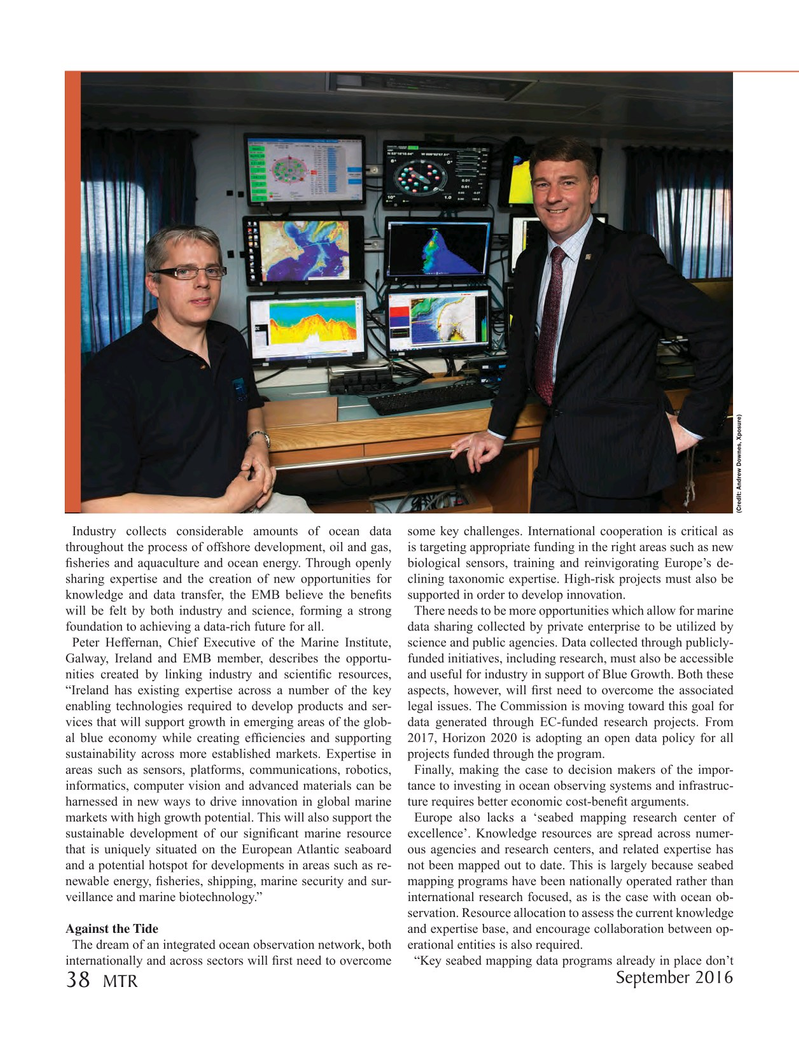
Page 38: of Marine Technology Magazine (September 2016)
Ocean Observation: Gliders, Buoys & Sub-Surface Networks
Read this page in Pdf, Flash or Html5 edition of September 2016 Marine Technology Magazine
(Credit: Andrew Downes, Xposure)
Industry collects considerable amounts of ocean data some key challenges. International cooperation is critical as throughout the process of offshore development, oil and gas, is targeting appropriate funding in the right areas such as new ? sheries and aquaculture and ocean energy. Through openly biological sensors, training and reinvigorating Europe’s de- sharing expertise and the creation of new opportunities for clining taxonomic expertise. High-risk projects must also be knowledge and data transfer, the EMB believe the bene? ts supported in order to develop innovation. will be felt by both industry and science, forming a strong There needs to be more opportunities which allow for marine foundation to achieving a data-rich future for all. data sharing collected by private enterprise to be utilized by
Peter Heffernan, Chief Executive of the Marine Institute, science and public agencies. Data collected through publicly-
Galway, Ireland and EMB member, describes the opportu- funded initiatives, including research, must also be accessible nities created by linking industry and scienti? c resources, and useful for industry in support of Blue Growth. Both these “Ireland has existing expertise across a number of the key aspects, however, will ? rst need to overcome the associated enabling technologies required to develop products and ser- legal issues. The Commission is moving toward this goal for vices that will support growth in emerging areas of the glob- data generated through EC-funded research projects. From al blue economy while creating ef? ciencies and supporting 2017, Horizon 2020 is adopting an open data policy for all sustainability across more established markets. Expertise in projects funded through the program.
areas such as sensors, platforms, communications, robotics, Finally, making the case to decision makers of the impor- informatics, computer vision and advanced materials can be tance to investing in ocean observing systems and infrastruc- harnessed in new ways to drive innovation in global marine ture requires better economic cost-bene? t arguments.
markets with high growth potential. This will also support the Europe also lacks a ‘seabed mapping research center of sustainable development of our signi? cant marine resource excellence’. Knowledge resources are spread across numer- that is uniquely situated on the European Atlantic seaboard ous agencies and research centers, and related expertise has and a potential hotspot for developments in areas such as re- not been mapped out to date. This is largely because seabed newable energy, ? sheries, shipping, marine security and sur- mapping programs have been nationally operated rather than veillance and marine biotechnology.” international research focused, as is the case with ocean ob- servation. Resource allocation to assess the current knowledge
Against the Tide and expertise base, and encourage collaboration between op-
The dream of an integrated ocean observation network, both erational entities is also required. internationally and across sectors will ? rst need to overcome “Key seabed mapping data programs already in place don’t
September 2016 38
MTR
MTR #7 (34-49).indd 38 8/24/2016 1:35:47 PM

 37
37

 39
39
